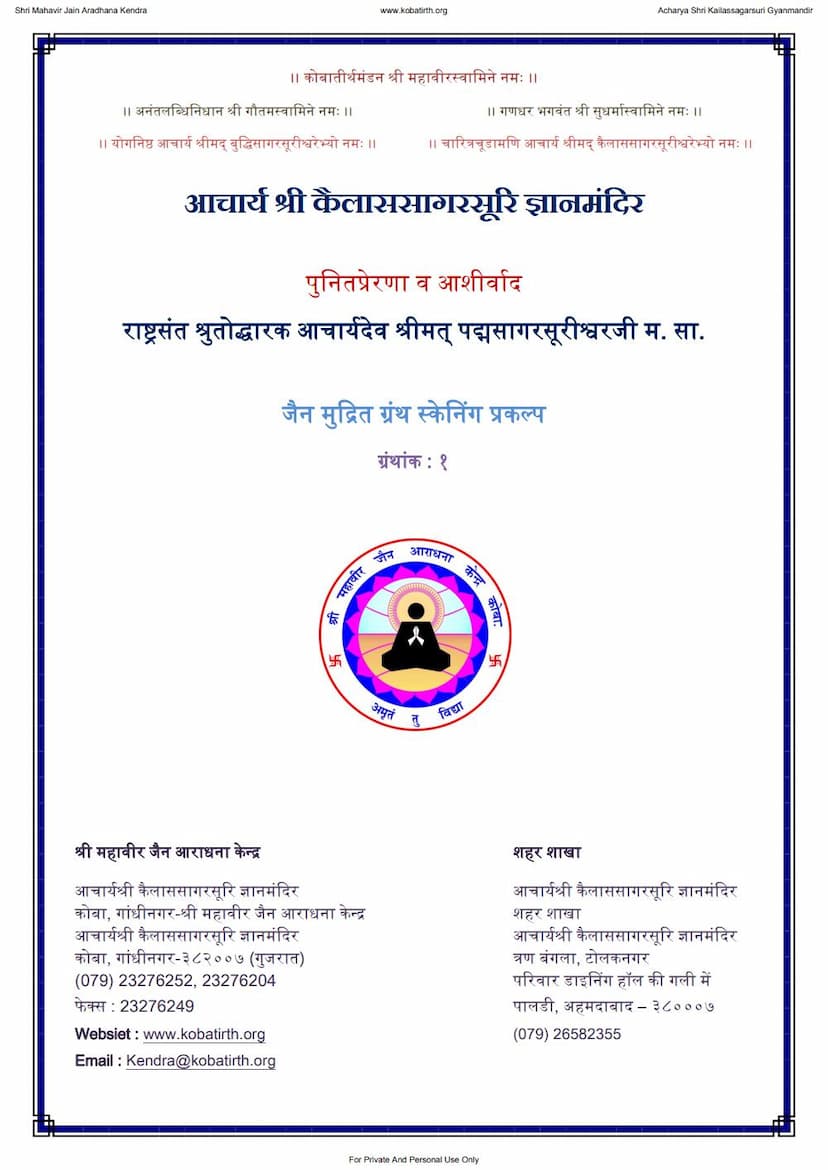Nadigyan Tarangini
Added to library: September 2, 2025

Summary
The book "Nadigyan Tarangini" (नाडीज्ञानतरंगिणी), authored by Hargovinddas Harjivandas, published by Hargovinddas Harjivandas, and available at the JainQQ link provided, is a comprehensive treatise on Ayurvedic medicine with a strong emphasis on pulse diagnosis (Nadi Pariksha) and the proper use of medicinal substances and their adjuncts (Anupan). The text, written in Gujarati, draws heavily from classical Ayurvedic texts like Vagbhata and Bharadwaj Samhita, and also incorporates information from Shiv Samhita.
Here's a summary of its key aspects, based on the provided pages:
I. Introduction and Purpose:
- The book aims to impart knowledge beneficial for both physicians and the general public, focusing on diagnosing diseases and understanding their remedies.
- It highlights the importance of Nadi Pariksha (pulse diagnosis) as a crucial method for understanding a patient's condition.
- It also emphasizes the significance of Anupan (correct vehicle or adjuvant for medicine), stating that the same medicine can yield different results with different Anupans.
II. Diagnostic Methods (Pariksha): The text details various diagnostic methods recommended in Ayurveda:
- Darshan (Observation): This includes observing the patient's appearance, eyes, tongue, urine, stool, and subtle signs.
- Sparshan (Palpation): Primarily focusing on feeling the pulse (Nadi Pariksha) to understand its various qualities, rhythms, and indications related to different doshas (Vata, Pitta, Kapha). It also includes feeling the body for heat, coldness, etc.
- Prashan (Inquiry): Asking the patient about their symptoms, diet, lifestyle, and other relevant factors.
- Nadi Pariksha (Pulse Diagnosis): This is a major focus. The book elaborates on:
- How to perform pulse diagnosis correctly.
- The qualifications of a physician suitable for pulse diagnosis.
- The conditions of the patient that are conducive to accurate pulse diagnosis.
- The methodology of feeling the pulse, including the correct hand and finger placement.
- The variations in pulse speed, rhythm, strength, and qualities associated with different doshas (Vata, Pitta, Kapha, and their combinations), fevers (Jvar), and dietary influences.
- Specific pulse characteristics indicating curable (Sadhyam) and incurable (Asadhyam) conditions.
- The influence of the time of day and the season on the pulse.
- The relationship between pulse diagnosis and the age of the patient and their inherent constitution (Prakriti).
- The pulse patterns indicative of specific diseases and conditions.
- Other Diagnostic Signs: The text also briefly mentions examination of urine (Mutra Pariksha) and stool (Mala Pariksha), taste (Ras Pariksha), nose (Nasa Pariksha), dreams (Swapna Pariksha), sounds (Shabda Pariksha), and omens (Shakun Pariksha).
III. Pharmaceutical Aspects (Dravya Guna Vidnyan): The book delves into the properties and preparation of various medicinal substances, crucial for Ayurvedic treatment:
- Identification of Substances: It lists and describes various metals (Dhatu), up-metals (Updhatu), mineral salts (Upras), gems (Ratna), poisonous substances (Vish), and sub-poisons (Upavish).
- Purification and Calcinations (Shodhan and Maran): A significant portion is dedicated to detailing the processes of purifying and preparing the calcinated ashes (Bhasma) of metals like gold, silver, copper, lead, iron, tin, zinc, mercury, and various minerals and herbs. The text provides detailed instructions on the specific methods, procedures, and adjuvants (Anupan) required for each.
- Properties and Indications: For each substance, it describes its taste, potency, post-digestive effect (Vipaka), therapeutic properties, and the diseases it can treat.
- Adulteration and Contraindications: It also warns about the dangers of using impure or unrefined substances and the adverse effects they can cause, along with methods to counteract these effects.
IV. Treatment Principles:
- Understanding Prakriti: The text stresses the importance of understanding the patient's inherent constitution (Prakriti - Vata, Pitta, Kapha, or combinations) to tailor treatment.
- Diagnosis-based Treatment: It reiterates that treatment should be based on a thorough diagnosis using the methods described.
- Anupan: The critical role of Anupan is consistently highlighted as a means to enhance the efficacy and direct the action of medicines.
- Behavioral and Dietary Recommendations: The book touches upon seasonal influences (Ritu), geographical factors (Desh), and personal conduct (Vihara) that affect health and disease.
V. Other Important Sections:
- Duta Pariksha (Messenger Examination): It discusses how to evaluate the reliability and intentions of a messenger sent by the patient based on their demeanor, speech, and appearance.
- Shakun Pariksha (Omen Examination): It explains how to interpret omens encountered during the diagnostic process or when going to see a patient.
- Swapna Pariksha (Dream Interpretation): The text interprets the meaning of various dreams, indicating health, illness, or the prognosis of a disease.
- Ajeerna (Indigestion) and Viruddha Ahara (Incompatible Foods): It details the different types of indigestion and the remedies for them, along with a crucial section on foods that are incompatible when consumed together and their adverse effects.
- Visha (Poisons) and their Management: It categorizes different types of poisons (Sthavar and Jangam), their symptoms, and the specific antidotes and treatments required.
Overall Significance: "Nadigyan Tarangini" appears to be a practical guide for Ayurvedic practitioners, aiming to provide detailed knowledge of diagnosis and pharmacopoeia. Its systematic approach to explaining pulse diagnosis, alongside the intricate details of preparing and using medicinal substances, makes it a valuable resource in the study of Ayurveda. The inclusion of various diagnostic signs, dream interpretation, and management of poisons and indigestion further underscores its comprehensive nature. The text is presented in a manner that reflects traditional Indian medical knowledge, emphasizing the interconnectedness of diagnosis, medication, and patient management.